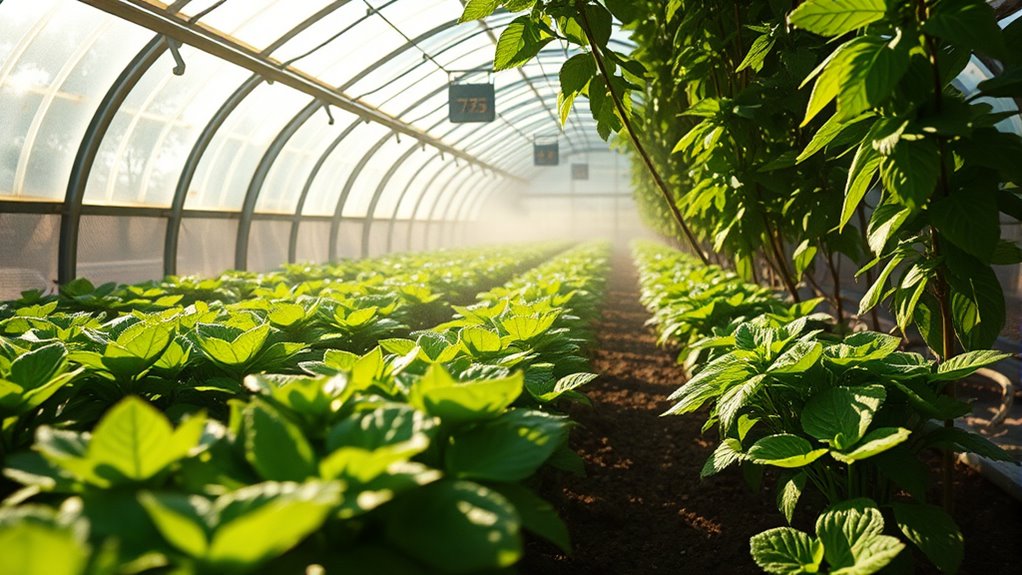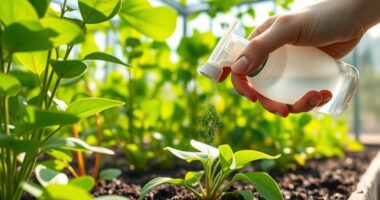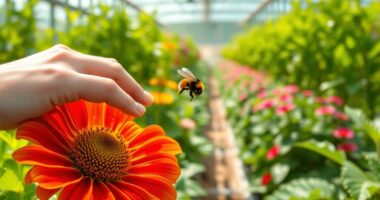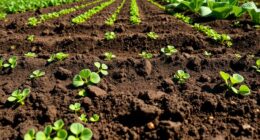To manage temperature for ideal plant growth, keep daytime levels 10-15°C higher than nighttime and create stable conditions. Use heating and cooling systems, shading techniques, and mulch to regulate temperatures. Monitor both air and soil temperatures to guarantee proper seed germination and nutrient availability. Pay attention to day-night temperature differences, as they influence growth and flowering. There's more to discover about maintaining perfect environments for your plants to thrive.
Key Takeaways
- Maintain day-night temperature differences by keeping daytime temperatures 10-15°C higher to promote optimal plant growth and development.
- Utilize heating and cooling systems, such as heating pads and fans, to regulate temperature effectively in greenhouses or indoor settings.
- Monitor temperature fluctuations with thermometers and controllers to ensure a stable environment for photosynthesis and overall plant health.
- Implement shading techniques and mulch to protect plants from extreme heat and regulate soil temperatures for better root development.
- Choose heat-resistant crop varieties and optimize planting schedules based on temperature forecasts to enhance resilience and yield.
Understanding Ideal Temperature Ranges for Plants
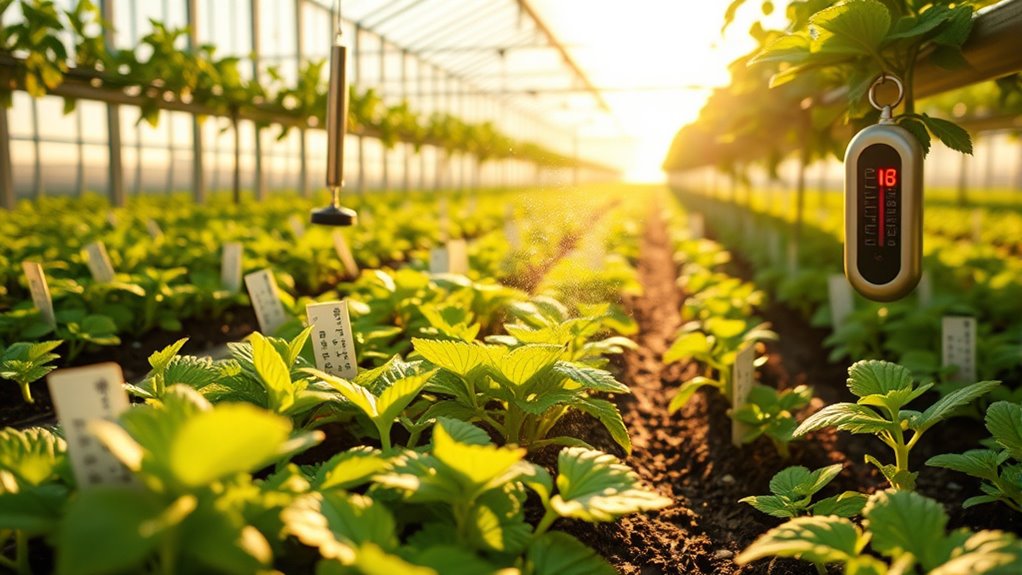
When you're managing plant growth, understanding the ideal temperature ranges for different types of plants is essential.
High-temperature plants, like African violets and cacti, thrive at 70-80°F during the day and 65-70°F at night.
High-temperature plants, such as African violets and cacti, flourish in warm environments of 70-80°F by day and 65-70°F by night.
In contrast, cool-temperature plants, such as azaleas and jasmine, prefer 50-60°F during the day and 45-55°F at night.
Medium-temperature plants, including amaryllis and begonias, do best at 60-65°F during the day and 55-60°F at night.
Tropical plants need constant warmth above 60°F, while alpine plants prefer cooler conditions below 60°F.
Keep in mind that seasonal adjustments may be necessary, as temperature preferences can vary with the changing seasons, impacting your plants' health and growth.
Effects of Temperature on Key Plant Processes
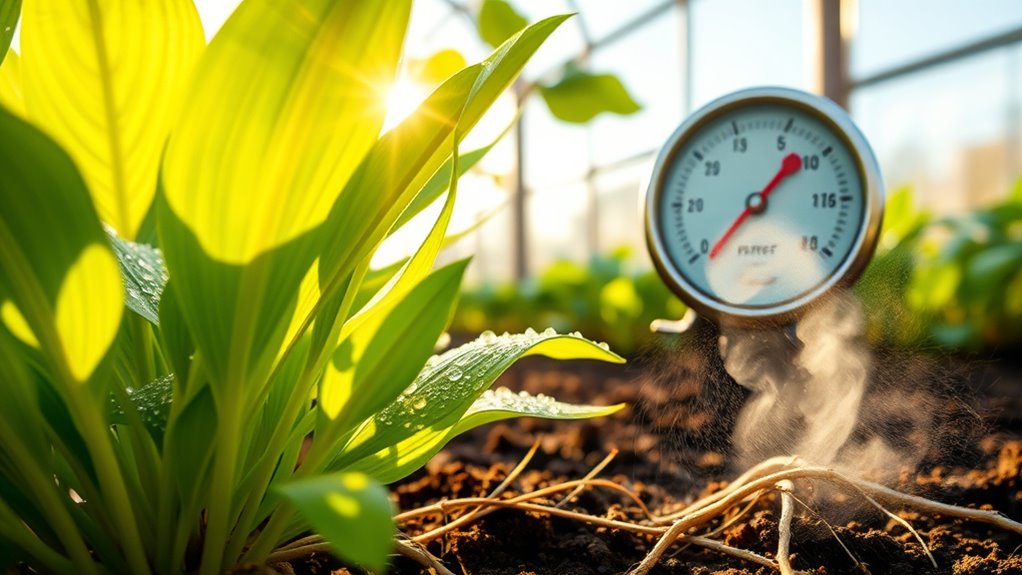
Understanding how temperature affects key plant processes is critical for successful growth and development.
Photosynthesis thrives between 20°C and 30°C; outside this range, enzymes like Rubisco become less efficient, leading to reduced CO2 fixation. High temperatures, especially above 35°C, can greatly cut photosynthetic efficiency and biomass, especially in crops like maize.
Elevated temperatures also increase transpiration, raising water demand and intensifying drought stress. For seed germination, specific temperature ranges are important; cool-season crops prefer 55°F to 65°F, while warm-season crops need 65°F to 75°F.
Additionally, plants adjust their metabolism to cope with temperature changes, producing heat shock proteins and antioxidants to safeguard against heat stress.
Maintaining ideal temperatures is essential for plant health and productivity.
Day-Night Temperature Differences and Plant Growth

Day-night temperature differences (DIF) play an essential role in shaping plant growth and development, as they directly influence various physiological processes.
A positive DIF, where daytime temperatures exceed nighttime ones, promotes stem elongation and enhances vascular development. On the other hand, a negative DIF inhibits stem growth and can delay flowering in some species.
You'll notice that different plants respond uniquely to DIF; for instance, tomatoes thrive under positive DIF conditions, while grasses show significant leaf extension.
Understanding and managing DIF in your greenhouse can help control plant height and optimize yields, mimicking natural outdoor conditions.
The Interaction Between Temperature and Light
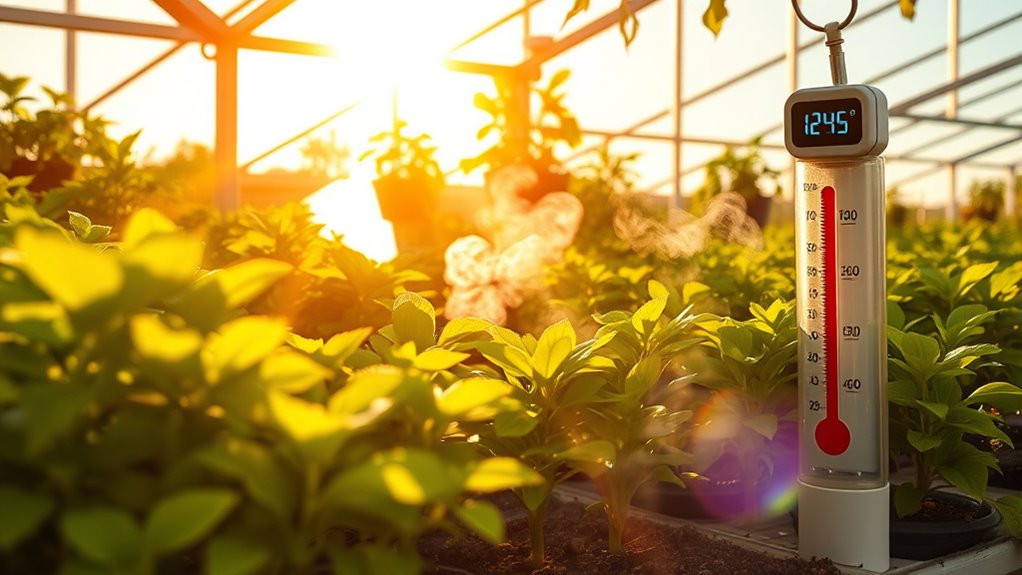
Temperature and light interact in complex ways that markedly affect plant growth and development.
Temperature and light intricately influence plant growth, significantly shaping their development and overall health.
You'll find that plants thrive best in temperatures between 21°-29°C, with best growth at 22°-26°C during the lit period. Higher light intensities require warmer temperatures for peak performance, while lower intensities favor cooler conditions.
If temperatures are off, photosynthesis efficiency drops, negatively impacting growth and yields. For enhanced growth, particularly with CO2 supplementation, aim for temperatures between 26°-29°C.
Daily temperature changes also matter; keeping daytime temperatures higher than nighttime promotes better photosynthesis and respiration.
Understanding this interaction helps you create the ideal environment for your plants, allowing them to maximize their potential under varying light and temperature conditions.
Soil Temperature's Role in Seed Germination
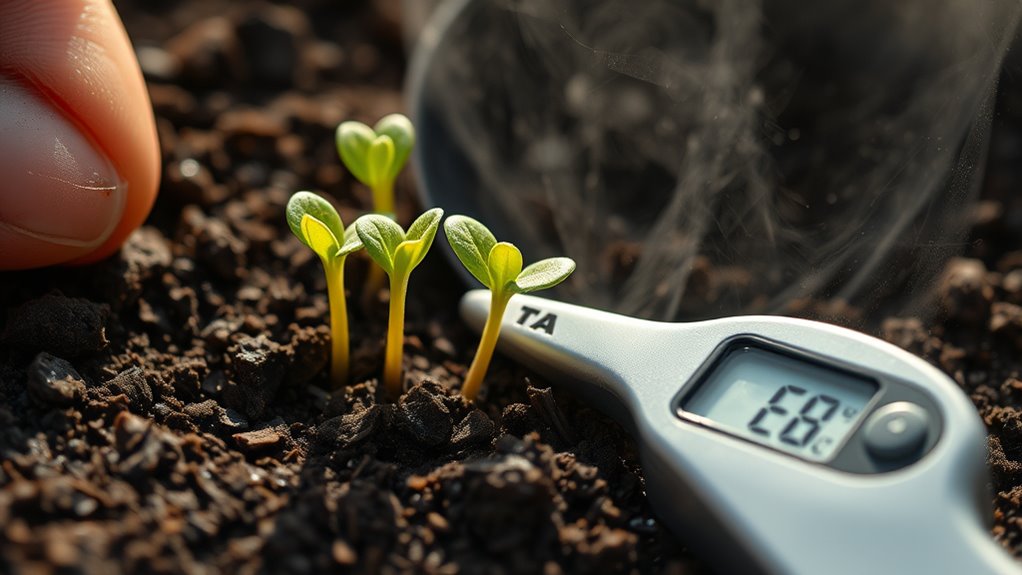
When it comes to seed germination, soil temperature plays an essential role in determining success.
You'll want to keep the soil temperature between 68°F and 86°F (20-30°C) for ideal germination. Some seeds, like peas, can sprout at 40°F (4°C), while others, like tomatoes, need at least 50°F (10°C).
Low temperatures can delay germination and increase disease risk, as metabolic processes slow down. Conversely, high temperatures can hinder growth, especially if they exceed the ideal range.
Always guarantee adequate soil moisture, as it's vital for germination.
To manage soil temperature, consider using thermometers, mulching, or covering the soil with plastic on sunny days to create a warm environment for your seeds.
Managing Temperature in Controlled Environments
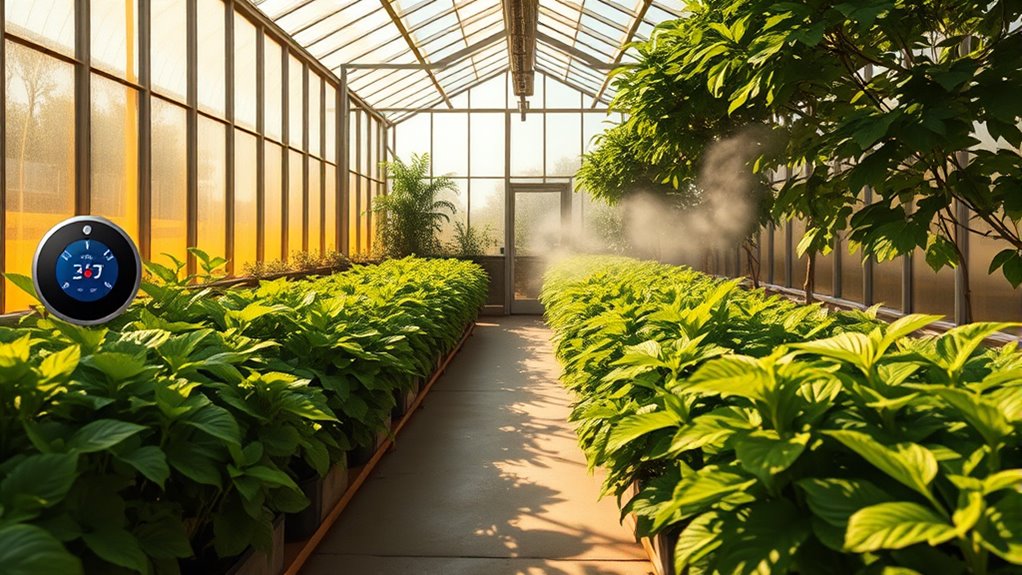
Managing soil temperature is just the beginning; maintaining the right conditions in controlled environments is essential for ideal plant growth.
You need to keep temperatures between 15°C to 30°C (59°F to 86°F) for most plants, ensuring they thrive. Use specialized equipment to manage extreme temperatures, and always plan your setup to avoid damaging the chambers.
Effective heating and cooling systems are vital for uniform temperature distribution. Pay attention to airflow to prevent hot or cold spots, which can stress plants.
Understanding the specific temperature needs of different species helps you cultivate healthier plants.
The Importance of Accurate Temperature Measurement

Accurate temperature measurement is essential for successful plant growth, as it directly influences important processes like photosynthesis and respiration.
Different plant species have unique temperature needs, so understanding these requirements helps you manage their growth effectively. Extreme temperatures can stress plants, making them more susceptible to diseases and impairing their growth.
Understanding the unique temperature needs of different plant species is crucial for effective growth management and disease resistance.
You can measure air, substrate, leaf, and canopy temperatures using thermocouples, thermometers, and infrared sensors. Proper sensor placement is fundamental for getting relevant readings.
Inaccurate measurements may lead to impaired growth, increased stress, and reduced yields. Consequently, precise temperature measurement allows you to adjust environmental conditions for ideal plant health and productivity, ensuring your plants thrive in their specific climates.
Strategies for Maintaining Optimal Temperature Levels
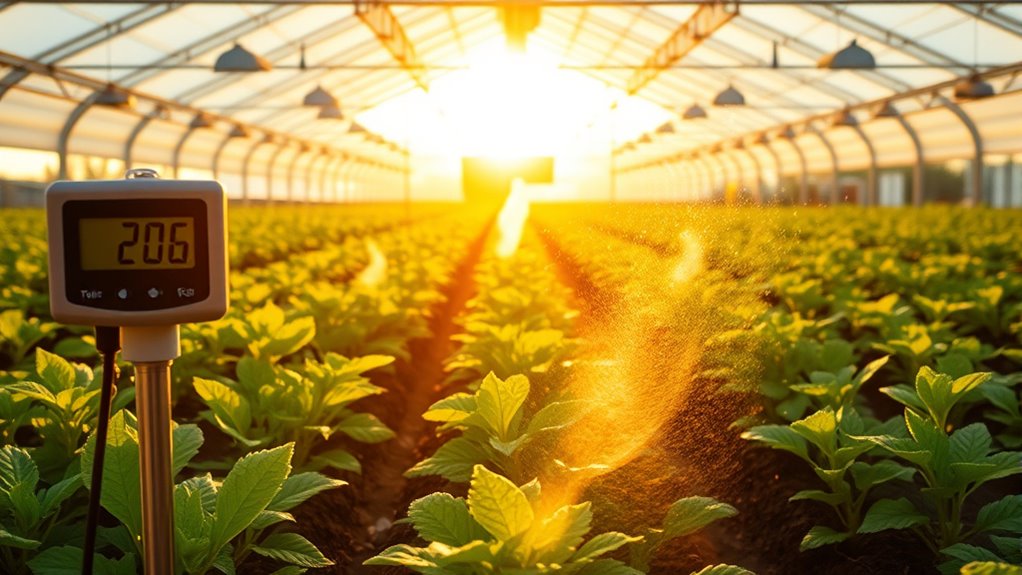
Temperature management plays an essential role in creating an ideal environment for plants to thrive. To maintain ideal temperature levels, start by utilizing heating and cooling systems like heating pads or moving plants to warmer or cooler spots.
You can also manage day-night temperature variations, keeping daytime temperatures 10-15°C higher to stimulate growth. In greenhouses, simulate ideal conditions year-round, and make seasonal adjustments to acclimate your plants.
Invest in monitoring tools, like thermometers and controllers, to keep an eye on temperature fluctuations. By implementing these strategies, you'll create a stable environment that supports photosynthesis, respiration, and overall plant development, ensuring your plants grow healthy and vibrant.
Common Temperature-Related Issues in Plant Growth
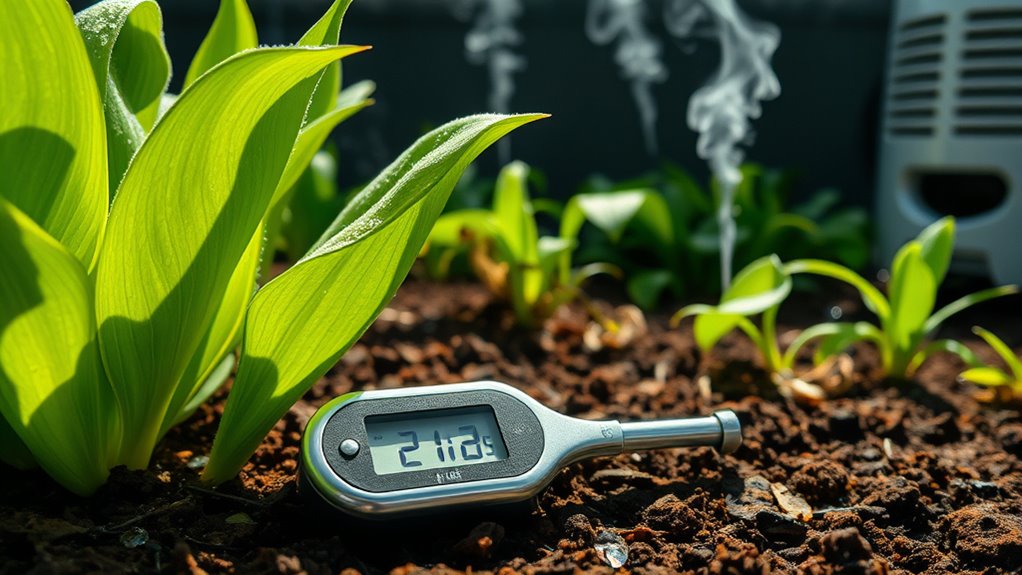
While cultivating plants, you may encounter various temperature-related issues that can hinder their growth and overall health. High temperatures disrupt photosynthesis, reducing growth and productivity.
High temperatures can severely impact plant growth by disrupting photosynthesis and reducing overall productivity.
As respiration rates increase, plants struggle with carbon dioxide and oxygen balance. You might also notice dehydration or poor water absorption in extreme heat.
Additionally, if temperatures aren't ideal, seed germination can suffer, leading to poor crop establishment. Reproductive issues arise too; heat stress impairs pollen viability and can reduce fruit set.
These challenges can ultimately lead to decreased crop yields and increased susceptibility to diseases and pests. Monitoring and managing temperature effectively is crucial to prevent these common issues and guarantee your plants thrive.
Frequently Asked Questions
How Does Temperature Affect Nutrient Uptake in Plants?
Temperature markedly affects nutrient uptake in plants. When it's too hot, nutrient-uptake proteins in roots decrease, hindering absorption, especially for nitrogen and phosphorus.
Conversely, cold root temperatures can also limit nutrient uptake, particularly potassium and phosphate. You'll find that maintaining root temperatures above 13°C promotes efficient nutrient absorption.
Fluctuations in temperature can disrupt patterns, making it crucial to monitor conditions and adapt to guarantee your plants receive the nutrients they need.
Can Temperature Fluctuations Impact Plant Disease Resistance?
Yes, temperature fluctuations can greatly impact plant disease resistance.
When temperatures rise or drop unexpectedly, it can alter the immune response of plants, making them more susceptible to pathogens.
For instance, higher temperatures often boost pathogen reproduction, while cooler ones can enhance resistance mechanisms.
What Are the Consequences of Extreme Temperature Events?
Imagine your garden wilting under a scorching sun or shivering in a frosty night.
Extreme temperatures wreak havoc on plants, disrupting photosynthesis and damaging proteins.
You'll see stunted growth and wilting leaves as dehydration sets in.
High heat can even hinder fruit development, while cold snaps trigger biochemical changes that slow metabolism.
Both extremes lead to lower yields and economic losses, making it essential to understand and address these harsh weather impacts on your plants.
How Do Temperature Changes Influence Pollination Success?
Temperature changes greatly influence pollination success.
When temperatures fluctuate, you might notice reduced pollen viability and altered pollinator activity. Warmer conditions can lead to decreased visits from pollinators, as floral rewards and cues change.
Additionally, low temperatures can slow pollen tube growth, impacting fertilization.
If you manage these temperature effects, like adjusting bloom times or introducing alternative pollinators, you can enhance pollination and ultimately improve your crop yields.
Are There Specific Plants That Thrive in Extreme Temperatures?
Did you know that certain plants can survive temperatures exceeding 120°F?
If you're looking for plants that thrive in extreme heat, consider Agave, which stores water in its thick leaves, or Lantana, known for its vibrant flowers.
Desert Marigold and Red Yucca also shine in hot conditions, while the Palo Verde tree's deep roots help it access essential water.
These hardy plants can transform your garden into a resilient oasis.
Conclusion
In conclusion, managing temperature is essential for optimal plant growth. For instance, consider a greenhouse grower who noticed stunted tomato plants due to fluctuating temperatures. By installing a temperature control system, they maintained a steady environment, resulting in healthier plants and a 30% increase in yield. By understanding and regulating temperature, you can create the ideal conditions for your plants to thrive, leading to better growth, productivity, and overall success in your gardening or farming endeavors.
